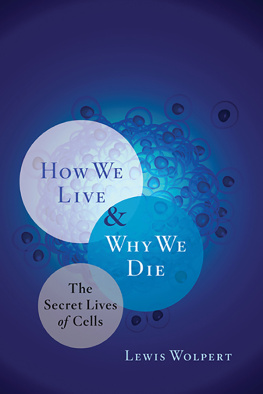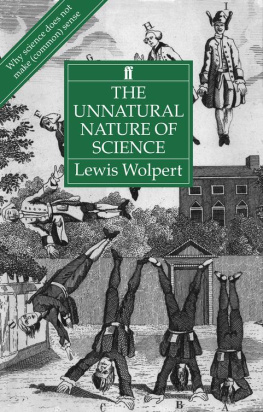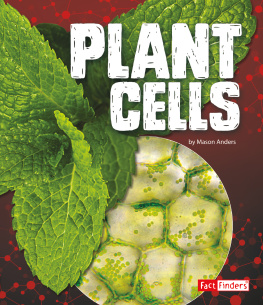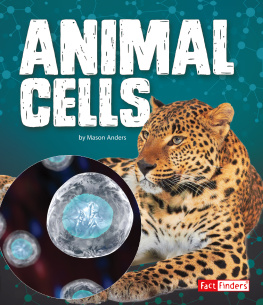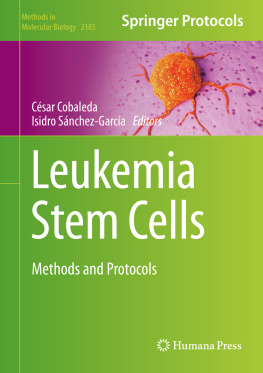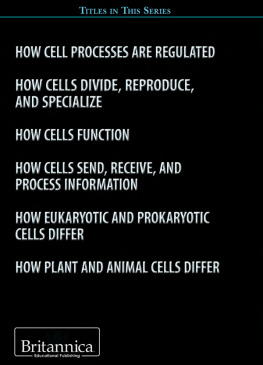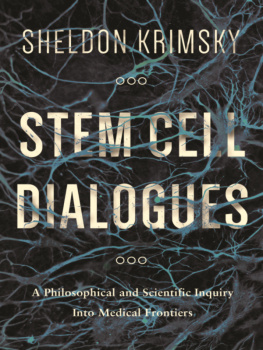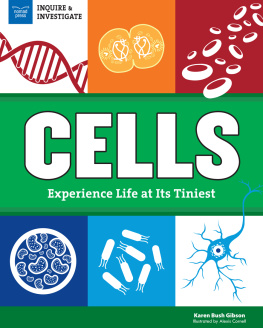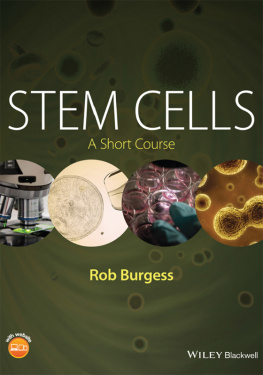
Also by Lewis Wolpert
THE UNNATURAL NATURE OF SCIENCE
MALIGNANT SADNESS:
THE ANATOMY OF DEPRESSION
SIX IMPOSSIBLE THINGS BEFORE BREAKFAST:
THE EVOLUTIONARY ORIGINS OF BELIEF
Copyright 2009 by Lewis Wolpert
First American Edition 2009
First published in Great Britain in 2009 by
Faber and Faber Limited
All rights reserved
For information about permission to reproduce selections from
this book, write to Permissions, W. W. Norton & Company, Inc.,
500 Fifth Avenue, New York, NY 10110
For information about special discounts for bulk purchases,
please contact W. W. Norton Special Sales at
specialsales@wwnorton.com or 800-233-4830
The Library of Congress has catalogued the printed edition as
follows:
Wolpert, L. (Lewis)
How we live and why we die : the secret lives of cells /
Lewis Wolpert.1st American ed.
p. cm.
First published in Great Britain in 2009 by Faber and Faber
Limited.
Includes bibliographical references and index.
ISBN 978-0-393-07221-1 (hardcover)
1. CytologyPopular works. 2. Developmental cytology
Popular works.
I. Title.
QH582.4.W65 2009
571.6dc22
2009009718
ISBN 978-0-393-29272-5 (e-book)
W. W. Norton & Company, Inc.
500 Fifth Avenue, New York, N.Y. 10110
www.wwnorton.com
W. W. Norton & Company Ltd.
Castle House, 75/76 Wells Street, London W1T 3QT
WHAT AM I, LIFE? A THING OF WATERY SALT
HELD IN COHESION BY UNRESTING CELLS,
WHICH WORK THEY KNOW NOT WHY, WHICH NEVER HALT,
MYSELF UNWITTING WHERE THEIR MASTER DWELLS.
JOHN MASEFIELD
I am grateful for the help given me by a number of people. Alison Hawkes read many drafts and corrected both my English and my style. My agent Anne Engel made helpful suggestions, as did Eleanor Lawrence and Helen Jefferson-Brown. Julian Loose at Faber was, as always, invaluable and his co-worker Kate Murray-Browne was an excellent editor.
Contents
HOW WE LIVE AND WHY WE DIE
1
Introduction
Cells are the miracle of evolution. They are miraculous not in a religious sense, but because they are so amazing. Each of us is essentially a society of billions of cells that govern everything, from movement to memory and imagination. We come from just one single cell the fertilised egg. In fact, all life originated from one cell, billions of years ago.
Arriving at cell theory has been considered even more important to biology than Darwins theory of evolution, because it brought together so many diverse phenomena under a common concept. It explains how our body functions, which is vitally important when things go wrong and we get ill. We need to understand how the units in this society of cells function to understand a great variety of illnesses from cancer to strokes to Alzheimers disease. The future of medicine lies in cell science. We also need to understand why this community of cells ages, and the nature of death itself. When we are infected by disease-causing bacteria and viruses, the immune system tries to identify the foreign invaders and destroy them, and indeed goes to great lengths to do this. What drives and underlies these fundamental processes of life other than cells? And what is life itself?
Only a few years ago, discussions about cell biology were limited to a handful of scientific experts with little contact with the public. Today, they are in the news for both medical and ethical reasons. There are almost daily reports on stem cells, which may hold the promise of curing numerous diseases; on cloning; on increases in cancer and obesity; and on the use of DNA to detect bad genes and identify criminals. Cell biology is now the focus of general interest or alarm. Understanding how cells function helps to clarify these contentious issues.
Cells are the basis of all life, from thousands of different bacteria to the thousands upon thousands of different animals and plants. Cells are very small there are a million or so skin cells between your toes and your nose but for their size they are the most complex objects in the universe. Going up the scale, the collection of cells in our brains would see off all rivals for the complexity prize. And yet there is no overall controller of this cellular society: it is a true co-operative.
There is nothing living that is not made up of cells, even though their forms can vary from snails to elephants to roses. Cells can do a remarkable number of different things: skin cells cover and protect us, muscles contract, nerve cells conduct impulses, gut cells absorb food; cells form the vessels of the circulatory system, cells in the kidney filter the blood, immune system cells protect us from foreign invaders, blood cells carry oxygen, bone and cartilage cells give us support; and so on. Yet, in spite of the apparent differences between, for example, a nerve cell and a skin cell, they work by the same basic principles.
Each cell is surrounded by a thin and flexible membrane that controls what can get into and out of the cell. In many cases this membrane is in tight contact with neighbouring cells which are held together to form extensive sheets of cells, such as our skin and blood vessels. Inside each cell there are two major regions: the nucleus and the cytoplasm. A bit like a flattish disc, the nucleus is the most prominent structure and is itself bounded by a membrane that controls what can enter or leave the nucleus. Nuclei contain the DNA code for determining the sequence of amino acids in our proteins, but the proteins are made in the region surrounding the nucleus called the cytoplasm, where most of the cells functions are performed by proteins in a fluid environment. Also in the cytoplasm are small sausage-shaped units, the mitochondria, which provide energy for the cell, and other groups of membranes. Our red blood cells are an exception: here, all these elements have been thrown out during the cells development.
That our cells are so similar is hardly surprising, as they all develop from just one cell: the egg. From the fertilised egg many different structures in our body develop, some of astonishing complexity like the brain, and this development involves all sorts of cell activities such as the cells knowing where they are, changing shape to mould the embryo, and dividing to give rise to hundreds of different types of cells, from red blood cells to nerve cells.
Our brain and spinal cord, for example, come from an initially flat sheet of cells that folds up to form a tube. This extraordinary structure has its programme for development in the tiny fertilised egg. The brain itself, and all the rest of the nervous system, are no more than an impossibly complex set of millions of interacting nerve cells. These interactions are based on the electrical impulses that nerve cells send along one of their long extensions. The nerve cells send messages to our muscles to make them contract. They also interact with each other in ways that enable us to learn, think and feel, and in addition there are special cells that are sensitive to light in our eye, others that are sensitive to a variety of smells in our nose, and others in our skin which can feel pain and detect touch and temperature. Emotions love, sadness, pain have their origins in cells.
It was cell division that led me into cell biology at the age of twenty-five. I had been trained as a civil engineer and had worked doing research on the mechanical properties of soils in relation to the stability of foundations. But this was not sexy enough for me; I wanted to do research on something more exciting, and many friends knew that I was searching for a new field of enquiry. Very fortunately, one close friend was getting married away from his home town, and he went to the local library while preparations for the party were being made by others. He was already interested in cells and came by chance on a paper in a journal discussing the application of mechanical principles to attempts to understand how a cell divided into two. How did a constriction form on the surface of a spherical cell and so divide it into two cells? He wrote to me and suggested that this was the problem that I should work on. I did, and fell in love with cells and embryos.
Next page
